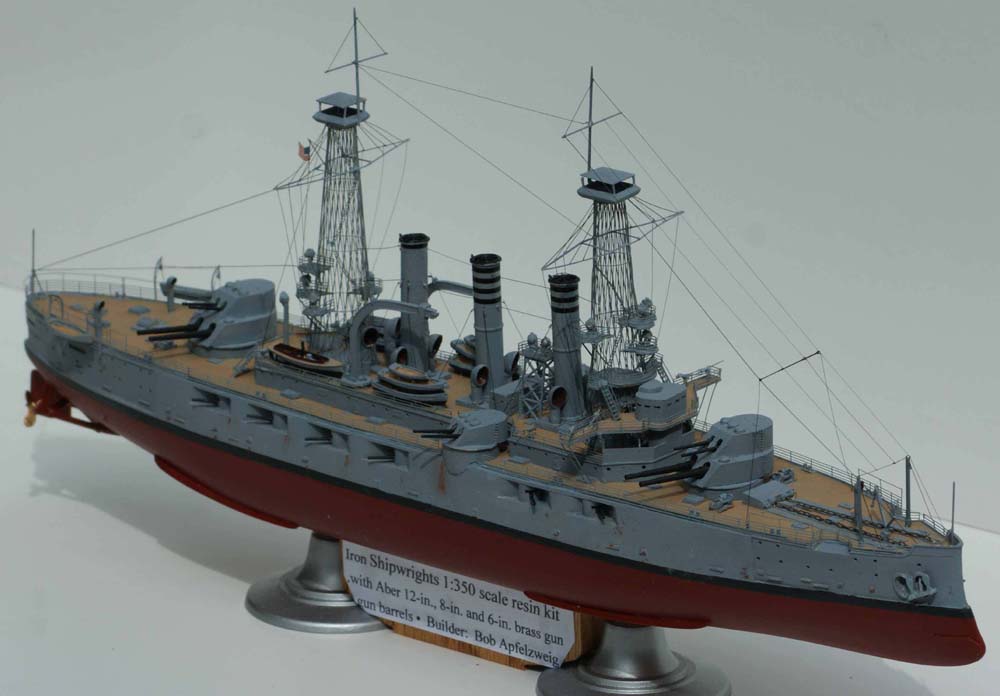
1/350 USS Virignia, BB13 (ISW)
|
by Robert Apfelzweig |

1/350 USS Virignia, BB13 (ISW)
The USS Virginia was first of a class of five pre-dreadnought battleships, commissioned in 1906, which carried over the curious and largely unsuccessful two-storied gun turrets from the older Kentucky class. These ships, displacing about 15,000 tons, were part of the Great White Fleet that circumnavigated the globe early in the last century to display American naval power. A few years later, following the successful introduction of the first true US Dreadnought-type battleships Michigan and South Carolina, these ships, like nearly all older battleships, were refitted with cage masts to replace the older thick military masts, and so that is how the ship is portrayed and how Iron Shipwrights designed its kit. They generally had uneventful careers but served on convoy duty during World War I and brought back home thousands of doughboys after the war ended; the Virginia and her sistership New Jersey were sunk as floating targets in September 1923, when the US Army Air Service, flying (what were for that time) large Martin bombers directed by General Billie Mitchell, dropped an 1100-lb. bomb on each one -- proving for the first time that capital ships could be sunk by air attacks at sea.ISW's kit has some serious issues with the quality of instructions (a common problem with this manufacturer) and the quality of certain smaller kit parts. The solid one-piece hull, typically for ISW, is very well cast and required little sanding or putty-filling except for parts of the keel. The gun turrets are cast as solid resin parts with both the forward and aft 12-in. and 8-in. turrets attached and the smaller wing 8-in. turrets separately cast; the gun barrel openings are much too long and needed to be puttied in and the gun openings drilled. The kit came with 4 brass 12-in. barrels but no others except for a few (presumably) 8-in. barrels that were much too large and more resembled palm tree trunks. I used Aber 8-in. and 6-in. brass barrels. The ship also had a significant but variable number (and location) of small 1-pdr. guns; I used the six that came in the kit and added a few more from my plastic spare parts stash and equipped them with Master Model 37 mm gun barrels, though these are probably too long for true accuracy. The deck features on the hull were generally good but there were no bollards, so I used Flyhawk US Navy bollards. Also, there were insufficient resin searchlights in the kit and those that were present were the wrong shape and size, so I installed Northstar Models 24-in. US Navy searchlights in resin and brass. The kit's searchlight platforms are the wrong shape and can be used only if the model is to represent a ship during WWI (the kit provides separate torpedo spotting platforms that were installed during the war), but if modeling a pre-WWI ship the platforms must be cut or broken and repositioned so that single circular searchlight pads are on the port and starboard sides of the cage masts and two pads, one above the other, face forward on the foremast and aft on the mainmast. The Virginia also had an additional searchlight platform between the first and second funnels, which I scratchbuilt. The kit's cage masts (three are provided) were fairly easy to bend and shape although the instructions stated to use an included tool to make them perfectly round; no such tool was provided in the kit, nor was there an illustration of it. The masts are conical rather than the correct shape, which should narrow towards the top and then remain so up to the spotting platforms. Brass rods completed the mast tops. Rigging was from stretched plastic black sprue. The kit's only included decals were 45- and 46-star American flags; I made my own decals for the ship's name and the black funnel stripes. The instructions said to paint the ship's deck "wood colored" (I used Tamiya Deck Tan) and the hull, masts and superstructure "battleship grey", so I chose ModelMaster dark ghost grey enamel. The lower hull was sprayed with water-based Liquitex Cadmium Red Hue.
Regarding those instructions in the ISW kit, they are rather extensive in written descriptions but only two partial pages of crude drawings are included, so that it is best to consult with online photos or other sources to see how these ships actually appeared; the various other members of the class (e.g., USS New Jersey, USS Georgia, USS Rhode Island, USS Nebraska) can also be built but these ships varied (without any further description in the instructions) in their rigging, the shape of the spotting tops, and the number and placement of smaller secondary guns. Some, such as the Nebraska, also received a dazzle camouflage paint scheme during WWI. The ship's charthouse is supposed to fit inside the lower foremast but the instructions say to glue it flat onto the deck, which is impossible because there are hatches and skylights there; the illustrated instructions show the charthouse in the correct position but upside down. I scratchbuilt from plastic rods the triangular spars and various other parts associated with the primitive radio antennae that were strung from the bow to the foremast. Also, the anchors included in the kit were the wrong type (suitable only for older ships) and so I used some appropriate spares I had available. The silver plastic stands were from my spares stash.
